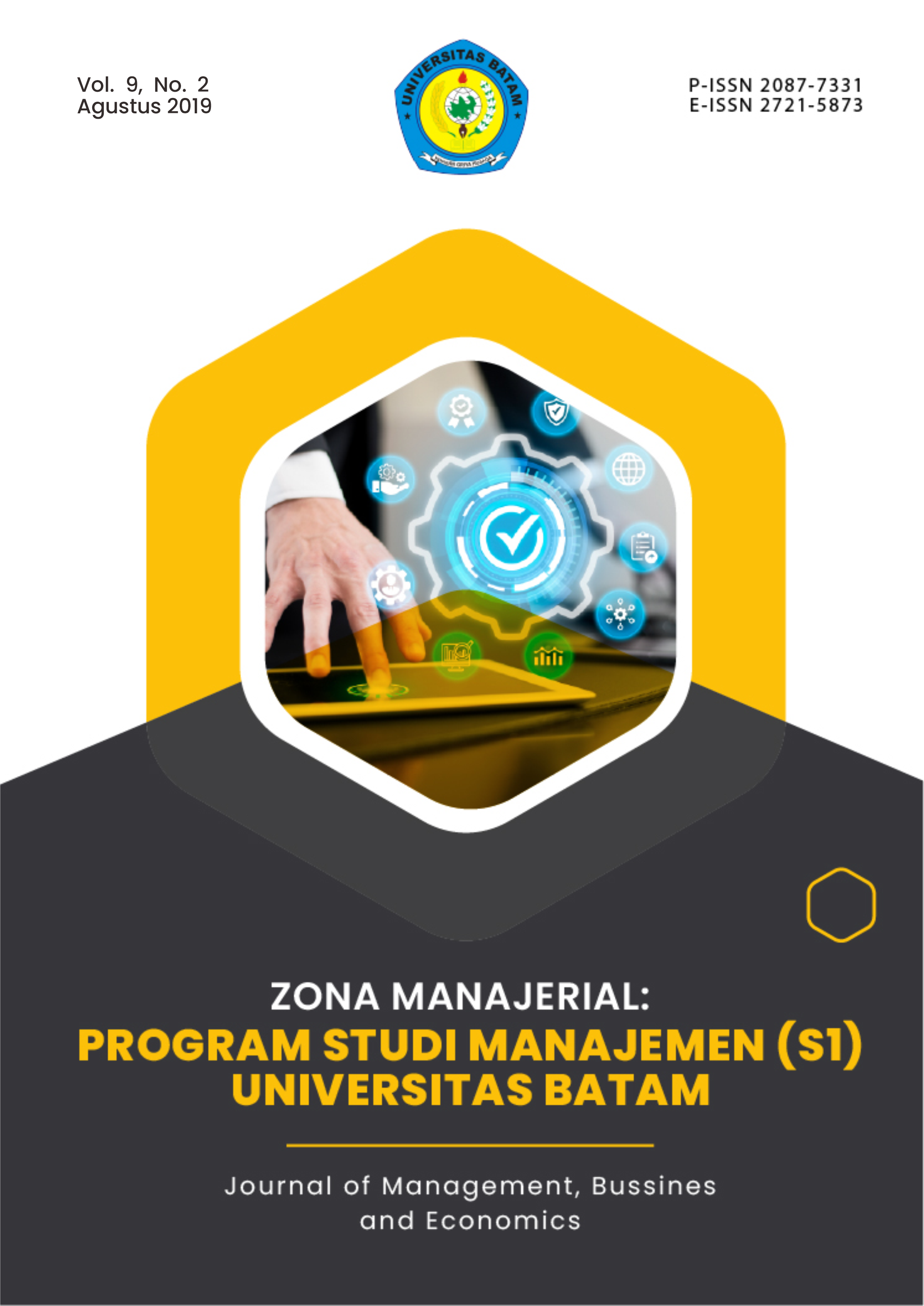EDUCATION, LEADERSHIP AND MOTIVATION DETERMINATION WITH DISCIPLINE OF WORK AS AN INTERVENING VARIABLES ON EMPLOYEE WORK EMPLOYEE WORK GENERAL, PROCEDURE AND ADMINISTRATION OF PROVINCIAL SPACES RIAU ISLANDS
DOI:
https://doi.org/10.37776/zm.v9i2.210Abstract
In this study, researchers used respondents' data, such as gender, age and duration of work of respondents to be able to provide information about the characteristics of respondents. Where from the questionnaire distributed questionnaire as many as 50 respondents using census techniques. Data analysis with parametric and non parametric statistics using SEM-PLS (Structural Equation Modeling-Partial Least Square) regarding research variables, instrument test, normality test, hypothesis test, and discussion of the results of hypothesis testing and Path Path Analysis. This study uses path analysis (path analysis) to test the pattern of relationships that reveal the influence of variables or a set of variables on other variables, both direct influence and indirect influence. The results of the study are as follows: The effect of the X3 variable on X4 has a P-Values value of 0.016 <0.05, so it can be stated that the influence between X3 and X4 is significant. The effect of the X3 variable on Y has a P-Values value of 0.006> 0.05, so it can be stated that the effect between X3 on Y is significant. The effect of the X4 variable on Y has a P-Values value of 0,000> 0.05, so it can be stated that the effect between X4 on Y is significant. The influence of X1 on X4 has a P-Values value of 0.006 <0.05, so it can be stated that the influence between X1 to X4 is significant. The effect of X1 on Y has a P-Values value of 0.006> 0.05, so it can be stated that the influence between X1 and Y is significant. The effect of the X2 variable on X4 has a P-Values value of 0.044 <0.05, so it can be stated that the influence between X2 on X4 is significant. The effect of X2 on Y has a P-Values value of 0.006 <0.05, so it can be stated that the effect between X2 on Y is significant.References
Anwar Prabu Mangkunegara, 2011. Evaluasi Kinerja SDM, Bandung, Penerbit Rafika Aditama.
As Ad. 2011. Pengembangan Sumber Daya Manusia.Jakarta: Bumi Aksara.
Arikunto Suharsimi. 2009. Manajemen Penelitian. Jakarta: Rineka Cipta.
Azwar Saifuddin. 2012. Reliabelitas dan Validitas seri Pengukuran Psikologi. Yogyakarta: Sigma Alfha.
Buhler, Patricia, 2011, Alpha Teach Yourself Management Skills, Edisi Pertama, diterjemahkan oleh Sugeng Haryanto, SukonoMukidi, dan M. Rudi Atmoko, Jakarta: Prenada.
Davis, Keith., 2010. Fundamental Organization Behavior, Diterjemahkan Agus Dharma, Jakarta: Erlangga
Dessler, Gary., 2009, Manajemen Sumber-daya Manusia, Jakarta: Prenhallindo.
Fattah, Nanang. 2012. Landasan Manajemen Pendidikan,bandung ; PT Remaja Rosdakarya
Gibson, James L., Invancevich, John M., dan Donnelly, Jame H. Jr., 2006. Organisasi, alih bahasa Ir. Nunuk Ardiani, MM. Jakarta: Bina Aksara.
Handoko, T Hani, 2010. Manajemen Personalia dan Sumber Daya Manusia. Yogyakarta: BPFE UGM.
Hamzah, 2009. Teori Motivasi dan Pengukurannya :Analisis Di Bidang Pendidikan. Cetaan Ketiga. Jakarta : Bumi Aksara.
Handoko, Hani., 2009. Manajemen, BPFE, Yogyakarta..
Khaddafi Muammar, Wahyuddin, heikal Mohd, falahuddin and maulida Rahmatul (2018), "Effect of Corporate Governance Mechanism, Independence and Management of Earnings Integrity of Financial Statements" Journal Quality Access to Success, Vol. 19, No. 164/June 2018.
Khaddafi Muammar, Raza Hendra, Heikal Mohd (2015), "Effect Of Budgetary Participation And Budget Adequacy On Individual Performance With Job Satisfaction As An Intervening Variable" International Journal of Economics, Commerce and Management, Vol. III, Issue 2, Feb 2015.
Maryoto, Susilo, 2010, Manajemen Sumber Daya Manusia. Yogyakarta: BPFE UGM.
Pamungkas Davit Imang, Ghazali Imam, Ahmad Tarmizi and Khaddafi Muammar (2018), "Corporate Governance Mechanisms in Preventing Accounting Fraud: A Study of Fraud Pentagon Model", Journal of Applied Economic Sciences Volume XIII, Issue 2 (56), Spring 2018.
Salusu, J. 2014. Pengambilan Keputusan Sitrategik Jakarta: Grasindo.
Santoso, Singgih. 2010. SPSS Versi 16 Mengolah Data Statistik Secara Frofesional: Jakarta: Gramedia.
Siagian Sondang P. 2010. Teori dan Praktik Kepemimpinan. Jakarta: Rineka Cipta.
Sedarmayanti. 2011. SDM dan Produktivitas Kerja. Bandung: Mandar Maju.
Sutarto. 2009. Dasar-Dasar Kepemimpinan Administrasi, Yokyakarta : Ghalia Indonesia
Sudjana. 2009. Metode Statistik. Bandung Tarsito
Thamrin Abdullah, 2012. Hubungan Motivasi Kerja, Lingkungan Kerja dan Kemampuan Manajerial atasan dengan Kepuasan Kerja Pegawai di Universitas Negeri Jakarta
Timpe, A Dale. 2011. Kinerja. Terjemahan Sofyan Cikmat Jakarta: PT. Gramedia Asri Media.
Tomatala Yakob, 2010. Kepemimpinan Yang Dinamis. Malang ;Gandum Mas
Downloads
Published
Issue
Section
License
Manuskrip yang diserahkan penulis haruslah sebuah karya yang tidak melanggar hak cipta (copyright) yang ada. Naskah yang dimasukkan harus yang belum pernah diterbitkan dan tidak dikirimkan pada waktu yang bersamaan kepada penerbit lain. Hak cipta atas semua material termasuk yang berbentuk cetak, elektronik dan bentuk lainnya dipegang oleh Jurnal Akuntansi. Setelah manuskrip telah melewati proses penyuntingan substansi dan positif diterima, penulis mengirimkan berkas Pernyataan Hak Cipta b ke alamat redaksi Jurnal Zona Manejerial.








